Spiritual Jewelry Symbols: Uncover Their Meaning
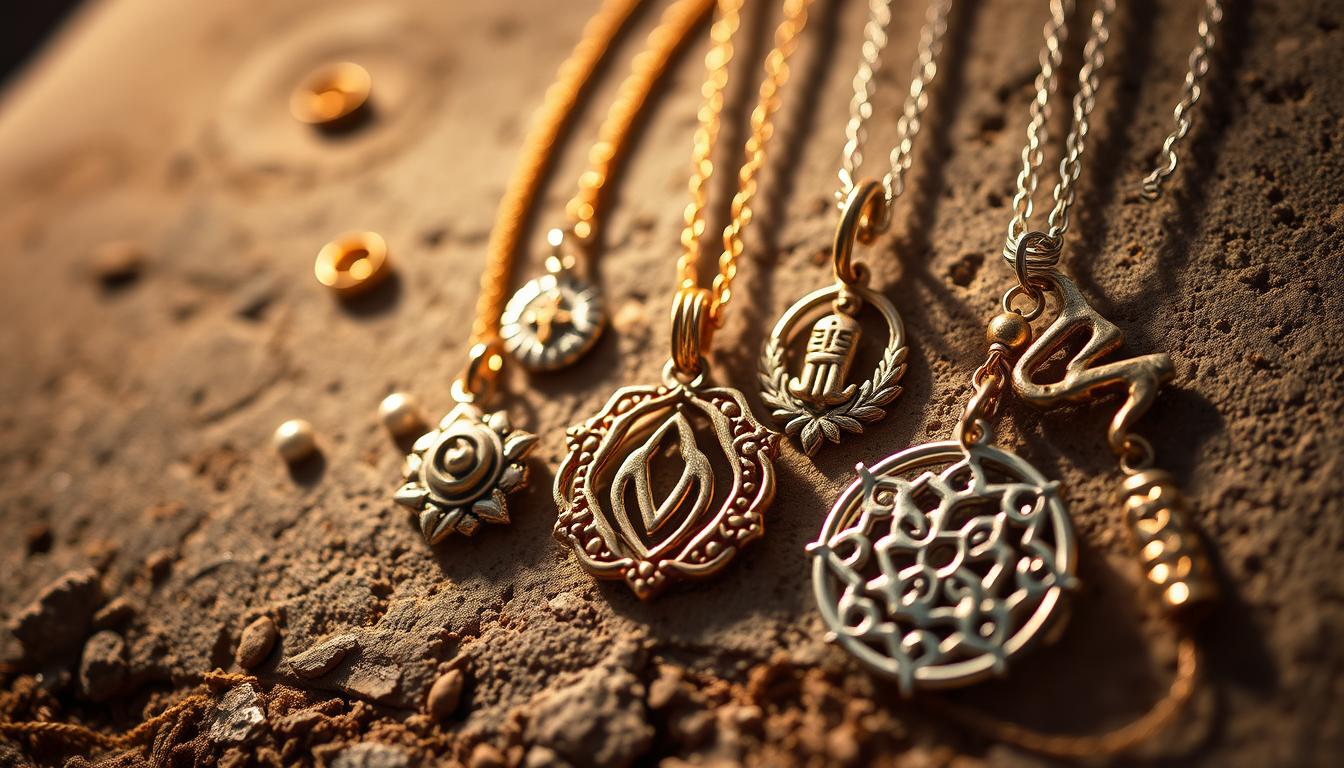
We have long been fascinated by the significance of spiritual jewelry symbols across various cultures and faiths. These symbols, often worn as adornments, carry deep meanings that connect us to our heritage and identity.
From the cross to the Star of David, and the Om symbol, each of these meaningful spiritual jewelry pieces conveys a unique message. They are more than just decorative items; they represent a deeper connection to one’s faith, culture, and personal values.
Key Takeaways
- Spiritual jewelry symbols hold significant cultural and religious meaning.
- These symbols are used in jewelry to convey spiritual significance.
- Different cultures and faiths have their unique spiritual jewelry symbols.
- The use of spiritual jewelry symbols connects wearers to their heritage.
- Meaningful spiritual jewelry pieces are more than just decorative items.
The Ancient Power of Symbols in Sacred Adornment
The use of sacred symbols in adornment dates back to ancient civilizations, where they played a crucial role in spiritual and religious practices. Symbols like the ankh and turquoise were not only aesthetically pleasing but also believed to possess spiritual powers, offering protection, guidance, and blessings to those who wore them.
Historical Significance of Wearing Sacred Symbols
Wearing sacred symbols has been a long-standing practice across various cultures, each imbuing these symbols with unique meanings and significance. In ancient Egypt, for instance, the ankh symbolized eternal life, while in many Native American cultures, turquoise was revered for its protective qualities. These symbols were often incorporated into jewelry, serving as a constant reminder of one’s spiritual beliefs and connection to the divine.
- Protection: Many symbols were believed to offer protection against negative energies or harm.
- Guidance: Symbols like the Eye of Horus were thought to provide guidance and wisdom.
- Spiritual Growth: Certain symbols, such as the lotus flower, represented spiritual growth and enlightenment.
How Symbols Connect Us to Deeper Spiritual Truths
Symbols have a profound ability to connect us to deeper spiritual truths, transcending linguistic and cultural barriers. They serve as a universal language, conveying complex spiritual concepts in a simple, yet powerful manner. By wearing symbolic jewelry, individuals can keep these spiritual principles close to their heart, fostering a deeper connection to their faith or spiritual practice.
“Symbols are the visual language of the soul, speaking directly to our deepest understanding of the world and our place within it.”
The continued use of sacred symbols in modern spiritual practices underscores their enduring significance. Whether through traditional designs or contemporary interpretations, these symbols remain a vital part of our spiritual expression, connecting us to a rich heritage of faith and spirituality.
Popular Spiritual Jewelry Symbols and Their Meanings

As we explore the realm of spiritual jewelry, we find that certain symbols have become ubiquitous, representing various aspects of spirituality and faith. These symbols not only add aesthetic value to the jewelry but also imbue it with deeper significance.
Spiritual jewelry has been a part of human culture for centuries, with different civilizations adopting and adapting various symbols to represent their beliefs and values. The use of spiritual symbol necklaces and other forms of spiritual healing jewelry continues to be a popular way to connect with one’s spirituality.
Universal Symbols Across Traditions
Some symbols have managed to transcend cultural and religious boundaries, becoming universally recognized and revered. For instance, the lotus flower is a symbol commonly found in spiritual jewelry, representing rebirth, enlightenment, and spiritual growth. Similarly, the evil eye is another widely used symbol believed to ward off negative energy and bring protection to the wearer.
Other universal symbols include:
- The cross, representing faith and sacrifice
- The Om symbol, signifying the universe and the connection to the divine
- The Star of David, representing harmony and balance
These symbols are often used in spiritual healing jewelry to promote spiritual growth, protection, and well-being.
The Evolution of Symbolic Jewelry Through History
The use of symbolic jewelry has evolved significantly over time, influenced by various cultural, religious, and historical factors. From ancient civilizations to modern times, symbolic jewelry has played a crucial role in representing spiritual beliefs and practices.
| Symbol | Historical Significance | Modern Interpretation |
|---|---|---|
| Lotus Flower | Represents rebirth and enlightenment in ancient Egyptian and Buddhist traditions | Continues to symbolize spiritual growth and enlightenment |
| Evil Eye | Believed to ward off negative energy in ancient Greek and Turkish cultures | Remains a popular symbol for protection against negative energy |
| Cross | Represents sacrifice and faith in early Christian traditions | Continues to be a powerful symbol of faith and spirituality |
By understanding the historical significance and evolution of these symbols, we can appreciate their continued relevance in modern spiritual jewelry.
Christian Symbols in Sacred Jewelry
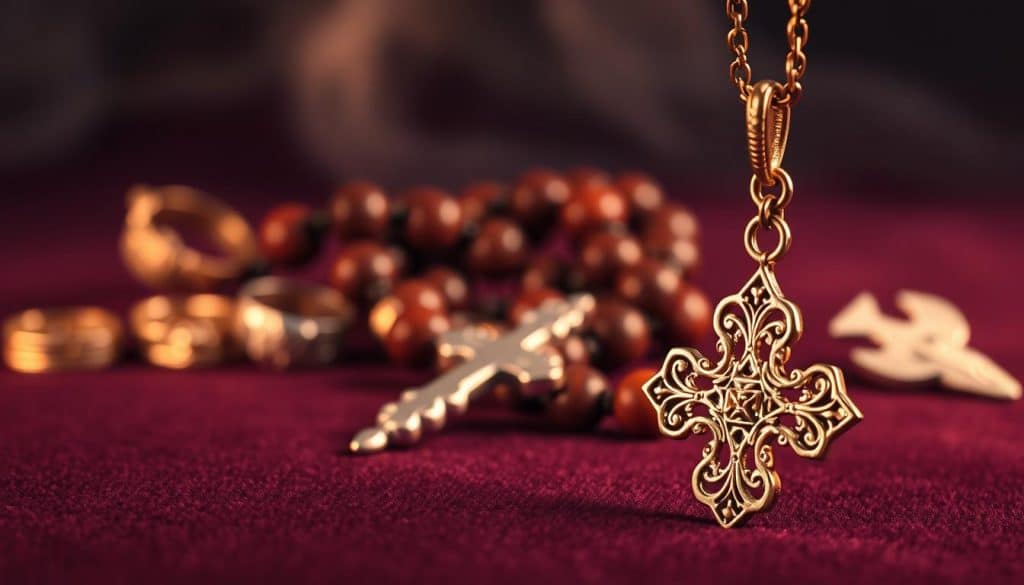
In Christian tradition, symbolic jewelry plays a significant role in expressing spiritual beliefs and values. These symbols serve as powerful reminders of faith, devotion, and spiritual commitment. Christian symbolic jewelry is not only a form of personal expression but also a way to connect with the broader Christian community.
The Cross and Its Many Variations
The cross is one of the most recognizable Christian symbols, representing the sacrifice and salvation through Jesus Christ. Over time, various forms of the cross have emerged, each with its own significance. For instance, the Latin cross is the most common form, while the Celtic cross combines the cross with a ring, symbolizing eternity.
Other variations include the Orthodox cross, which often features additional elements like the INRI inscription or the skull and crossbones, symbolizing the crucifixion. The cross is frequently used in jewelry, serving as a constant reminder of faith and devotion.
Fish, Dove, and Angel Motifs
Beyond the cross, other Christian symbols are commonly used in jewelry. The fish, for example, is an ancient symbol representing Christianity, derived from the Greek word “ichthys,” which is an acronym for “Jesus Christ, Son of God, Savior.” The dove is another significant symbol, often representing peace, love, and the Holy Spirit.
Angel motifs are also popular, symbolizing divine protection and guidance. These symbols are not only beautiful adornments but also carry deep spiritual meanings, making them significant in Christian sacred jewelry.
Saints Medals and Religious Iconography
Saints medals are another form of Christian symbolic jewelry, featuring images of saints and often used to invoke their protection or guidance. These medals are typically worn as a sign of devotion to a particular saint or as a reminder of the saint’s virtues and teachings.
Religious iconography, including images of Jesus, Mary, and other biblical figures, is also used in Christian jewelry. These icons serve as visual representations of faith and are often used in devotional practices.
| Symbol | Meaning | Common Use in Jewelry |
|---|---|---|
| Cross | Sacrifice and Salvation | Pendants, Necklaces |
| Fish | Christian Identity | Pendants, Rings |
| Dove | Peace, Love, Holy Spirit | Pendants, Charms |
| Angel Motifs | Divine Protection | Pendants, Earrings |
| Saints Medals | Devotion and Protection | Medallions, Pendants |
These Christian symbols, when used in jewelry, not only serve as beautiful adornments but also as meaningful expressions of faith. Whether it’s a cross, a fish, a dove, an angel motif, or a saint’s medal, each piece of symbolic jewelry carries a deep spiritual significance.
Buddhist and Hindu Sacred Symbols
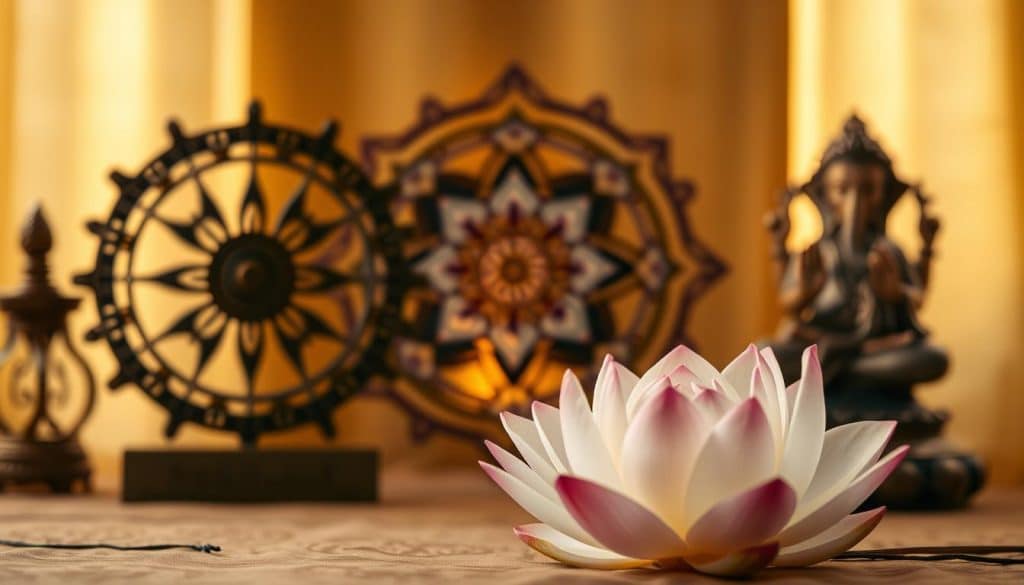
In Buddhist and Hindu traditions, sacred symbols are not merely decorative elements but are imbued with spiritual significance and power. These symbols, often featured in symbolic jewelry designs and spiritual symbol earrings, serve as tangible connections to the divine, facilitating spiritual growth and enlightenment.
Om Symbol: The Primordial Sound
The Om symbol is a sacred sound in Hinduism and Buddhism, representing the universe and the connection to the divine. It is often used in meditation and is a popular motif in spiritual jewelry.
Lotus Flower: Rising From Mud to Enlightenment
The lotus flower is another significant symbol, representing spiritual growth and enlightenment. Its journey from muddy waters to blooming beauty is a powerful metaphor for the spiritual path.
Buddha and Deity Representations in Jewelry
Representations of Buddha and various deities are common in Buddhist and Hindu jewelry, each carrying specific spiritual meanings. These representations serve as reminders of the qualities and teachings they embody.
| Symbol | Meaning | Tradition |
|---|---|---|
| Om | Primordial sound, connection to the divine | Hinduism, Buddhism |
| Lotus Flower | Spiritual growth, enlightenment | Buddhism, Hinduism |
| Buddha | Enlightenment, compassion | Buddhism |
Ancient Egyptian Spiritual Symbols
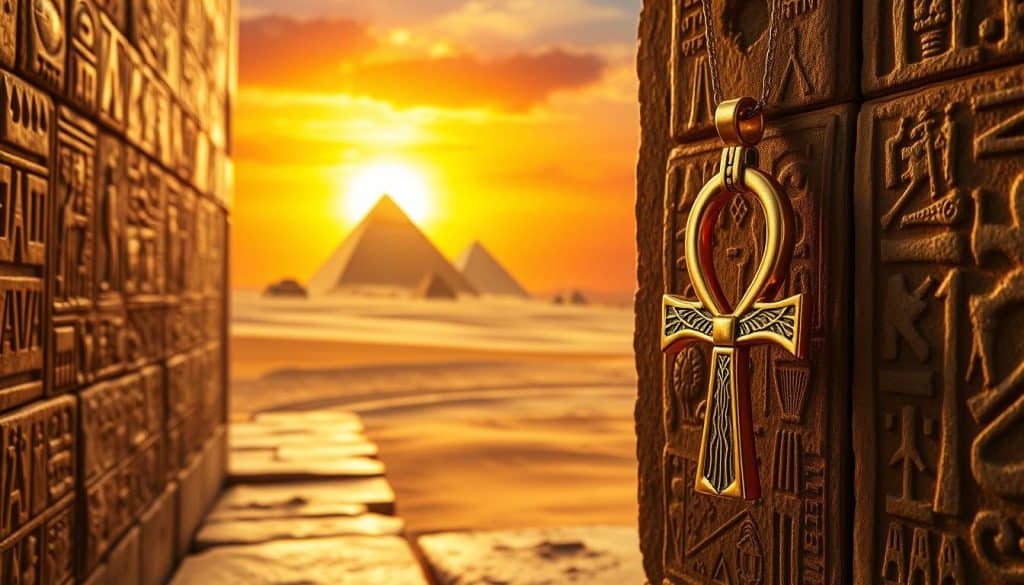
Ancient Egyptian spirituality is rich with symbols that continue to captivate us today. These symbols were not just decorative; they were believed to hold powerful spiritual significance, offering protection, guidance, and blessings to those who wore them.
The Eye of Horus: Divine Protection
The Eye of Horus is one of the most recognizable and revered symbols from Ancient Egypt. It represents divine protection, health, and restoration. According to myth, Horus lost his eye in a battle with Seth, and it was later restored by Thoth. This symbol was believed to offer its wearer protection from harm and evil spirits.
The Eye of Horus continues to be a popular motif in spiritual jewelry today. Its powerful symbolism resonates with those seeking protection and guidance on their spiritual journey.
Ankh: The Symbol of Eternal Life
The Ankh is another iconic symbol from Ancient Egypt, representing eternal life and vitality. Often depicted being held by gods and goddesses, the Ankh was believed to be a key to unlocking the afterlife. In spiritual jewelry, the Ankh symbolizes the wearer’s connection to eternal life and their aspiration for spiritual immortality.
“The Ankh is a potent reminder of the cyclical nature of life and death, and the potential for spiritual rebirth.”
Scarab Beetle: Transformation and Rebirth
The Scarab Beetle was highly revered in Ancient Egyptian culture, symbolizing transformation, rebirth, and regeneration. The beetle’s habit of rolling dung into a ball was seen as a metaphor for the sun god’s journey across the sky. In spiritual jewelry, the Scarab Beetle represents the wearer’s capacity for personal transformation and their journey towards spiritual enlightenment.
These Ancient Egyptian spiritual symbols continue to inspire and influence modern spiritual practices. By incorporating them into our jewelry, we connect with a rich legacy of symbolism that transcends time and culture.
Celtic and Norse Spiritual Jewelry Symbols
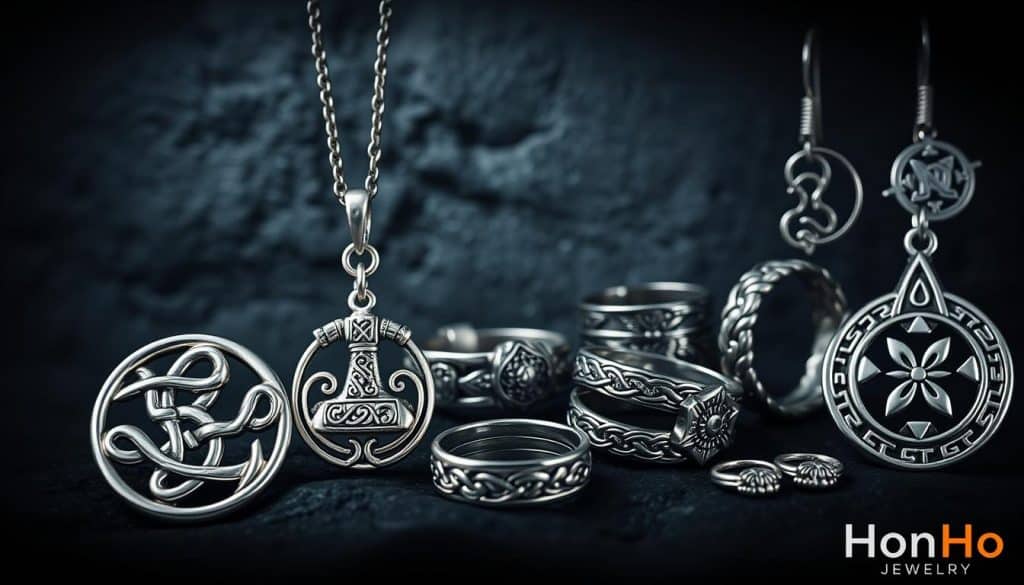
In the realm of spiritual jewelry, Celtic and Norse symbols stand out for their profound meaning and historical depth. These cultures have richly contributed to the world of spiritual adornment, using symbols that represented spiritual growth, protection, and connection to the divine.
Trinity Knot and Celtic Cross Meanings
The Trinity Knot, also known as the Triquetra, is a powerful symbol in Celtic spirituality, representing the interconnectedness of the mind, body, and spirit. It signifies eternal life and the unity of the three aspects of the self.
The Celtic Cross, another prominent symbol, combines the Christian cross with Celtic elements, often featuring a ring surrounding the intersection of the cross’s arms. This symbol is believed to represent the unity of heaven and earth, and the balance between spiritual and material aspects of life.
Tree of Life: Connecting Realms
The Tree of Life is a universal symbol that appears in various cultures, including Celtic and Norse traditions. It represents the connection between different realms: heaven, earth, and the underworld. In Celtic mythology, it’s associated with the Otherworld, a realm that exists alongside our own.
This symbol is often depicted as a tree with sprawling branches and deep roots, signifying the interconnectedness of all living things and the cycles of life and death.
Thor’s Hammer and Viking Protection Symbols
In Norse mythology, Thor’s Hammer, known as Mjolnir, is a potent symbol of protection and strength. It was believed to ward off evil and protect both the gods and humans from harm.
Norse protection symbols, including Thor’s Hammer, were often worn as jewelry to invoke the power of the gods and to safeguard the wearer against various dangers, both physical and spiritual.
| Symbol | Culture | Meaning |
|---|---|---|
| Trinity Knot | Celtic | Interconnectedness, eternal life |
| Celtic Cross | Celtic | Unity of heaven and earth |
| Tree of Life | Celtic/Norse | Connection between realms |
| Thor’s Hammer | Norse | Protection, strength |
Native American and Indigenous Spiritual Symbols
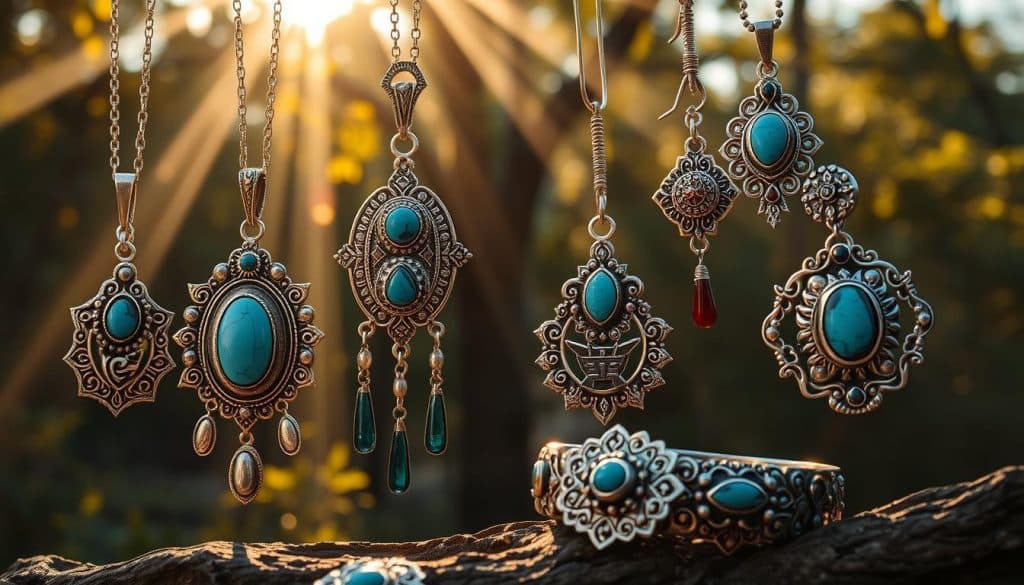
In Native American traditions, spiritual symbols play a crucial role in jewelry, serving as more than just decorative elements. These symbols are deeply rooted in the spiritual and cultural practices of Native American communities, often carrying significant meanings that are passed down through generations.
We observe that the use of these symbols in jewelry not only reflects the wearer’s spiritual beliefs but also connects them to their cultural heritage. The incorporation of such symbols into spiritual healing jewelry and spiritual symbol necklaces has become a meaningful way for individuals to express their spirituality.
Dreamcatcher and Medicine Wheel Symbolism
The dreamcatcher, a symbol originating from the Ojibwe Nation, is often used in spiritual jewelry to represent protection against negative energies. According to legend, dreamcatchers filter out bad dreams, allowing only good dreams to pass through. The medicine wheel, on the other hand, represents the interconnectedness of life and the balance between physical and spiritual well-being.
“The dreamcatcher is a powerful symbol that has become synonymous with Native American spirituality, representing the connection between the physical and spiritual worlds.”
Both symbols are frequently used in spiritual symbol necklaces, serving as reminders of the wearer’s spiritual journey and connection to Native American traditions.
| Symbol | Meaning | Representation in Jewelry |
|---|---|---|
| Dreamcatcher | Protection against negative energies | Pendant necklaces, earrings |
| Medicine Wheel | Interconnectedness of life and balance | Charms, pendants, rings |
Animal Totems and Their Spiritual Powers
Animal totems are another significant aspect of Native American spiritual symbolism. Each animal is believed to possess certain spiritual powers and characteristics that can guide individuals on their spiritual paths. For example, the eagle is often associated with strength and courage, while the wolf represents loyalty and perseverance.
These animal totems are frequently incorporated into spiritual healing jewelry, serving as powerful reminders of the qualities and strengths that individuals aspire to embody. By wearing jewelry featuring their animal totem, individuals can connect with the spiritual energies these animals represent.
We recognize the importance of respecting the cultural origins of these symbols and their significance in Native American traditions. As such, we strive to create spiritual symbol necklaces and other jewelry pieces that not only honor these traditions but also provide a meaningful way for individuals to express their spirituality.
Eastern Philosophical and Mystical Symbols
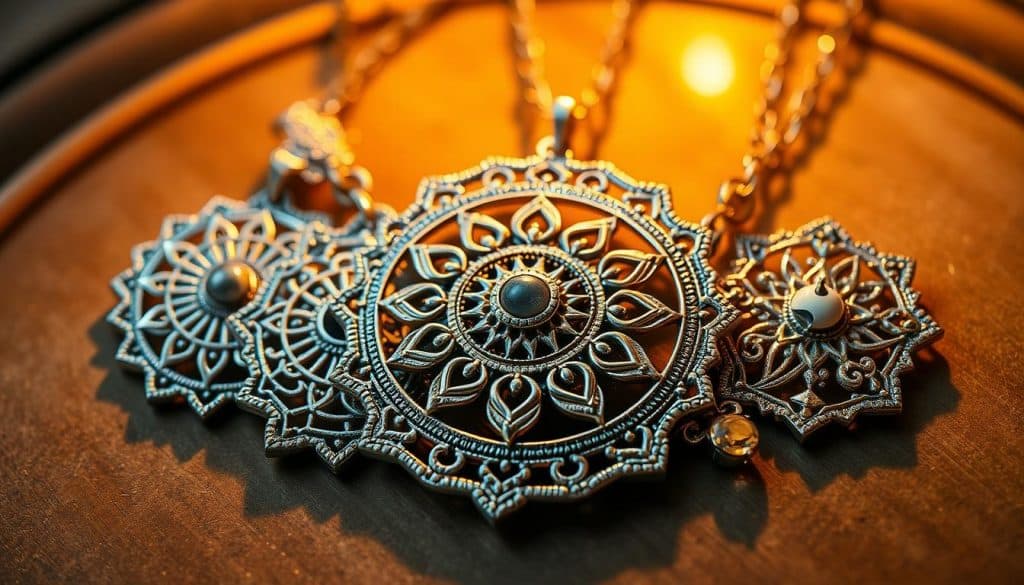
Eastern philosophical and mystical symbols are more than mere representations; they are gateways to deeper understanding and spiritual growth. These symbols have been integral to various Eastern cultures, serving as tools for spiritual practices and daily life.
Yin-Yang: The Balance of Opposing Forces
The Yin-Yang symbol is one of the most recognizable Eastern philosophical symbols, representing the harmony and interdependence of opposites. It signifies the cyclical nature of life, where opposing forces are interconnected and interdependent.
Key aspects of Yin-Yang include:
- Interconnectedness of opposites
- Cyclical nature of life
- Balance and harmony
Yin-Yang is often used in symbolic jewelry for energy, promoting balance and harmony in the wearer’s life.
I Ching Hexagrams and Feng Shui Symbols
The I Ching hexagrams are another significant aspect of Eastern philosophical symbolism, used for divination and guidance. These hexagrams are believed to offer insights into various life situations, helping individuals navigate challenges and make informed decisions.
Feng Shui symbols, on the other hand, are used to promote positive energy and harmony in one’s environment. These symbols are often incorporated into spiritual charm bracelets to enhance their effectiveness.
| Symbol | Meaning | Use in Jewelry |
|---|---|---|
| Yin-Yang | Balance and harmony | Symbolic jewelry for energy |
| I Ching Hexagrams | Divination and guidance | Meditation and spiritual growth |
| Feng Shui Symbols | Positive energy and harmony | Spiritual charm bracelets |
In conclusion, Eastern philosophical and mystical symbols like Yin-Yang, I Ching hexagrams, and Feng Shui symbols play a significant role in promoting spiritual growth, balance, and positive energy. Their incorporation into jewelry enhances their symbolic meaning, serving as constant reminders of the wearer’s spiritual path.
Astrological and Celestial Symbols in Spiritual Jewelry
The use of astrological and celestial symbols in jewelry represents a profound spiritual practice, linking individuals to the universe. These symbols, deeply rooted in ancient cultures, continue to inspire and guide people today.
Zodiac Signs as Personal Spiritual Guides
Zodiac signs are among the most popular astrological symbols used in spiritual jewelry. Each sign is associated with specific traits, strengths, and challenges, serving as a personal spiritual guide for the wearer. For instance, a person wearing a Leo symbol jewelry might be reminded of their inner courage and charisma. “The stars impel, they do not compel,” a quote often attributed to Claudius Ptolemy, reflects the belief that astrological signs can influence but not dictate our paths.
By wearing zodiac sign jewelry, individuals can connect with their astrological identity, fostering a deeper understanding of themselves and their place in the universe. This practice is not limited to any particular culture; zodiac symbolism is a universal language, understood and revered worldwide.
Sun, Moon, and Star Symbolism in Different Traditions
The sun, moon, and stars have been revered across various cultures for their spiritual significance. In many traditions, the sun symbolizes life, energy, and enlightenment, while the moon represents intuition, emotions, and the subconscious. Stars, often associated with destiny and guidance, are seen as messengers of the divine.
In spiritual jewelry, these celestial bodies are used to convey complex symbolic meanings. For example, a sun symbol might be worn to invoke inner light and positivity, whereas a moon symbol could represent a connection to one’s emotional and intuitive self. As
“The night is far more alive and richly colored than we ever suspect on a cloudless night when the stars are not veiled by a misty atmosphere, and when the moon is shining brightly.”
This quote highlights the profound impact of celestial bodies on our perception and spirituality.
By incorporating these symbols into jewelry, wearers can serve as a reminder of their spiritual aspirations and connections to the cosmos. Whether it’s through symbolic jewelry designs or spiritual symbol earrings, the representation of celestial bodies in jewelry continues to be a powerful means of personal expression and spiritual growth.
Sacred Geometry in Spiritual Symbol Jewelry
In the realm of spiritual jewelry symbols, sacred geometry plays a crucial role in representing the interconnectedness of the universe. Sacred geometry refers to the belief that certain geometric patterns and shapes have spiritual significance and reflect the underlying order of the universe.
Sacred geometry is used in various spiritual traditions to symbolize the harmony and unity that exist between the macrocosm and the microcosm. By incorporating these geometric patterns into jewelry, individuals can wear symbols that not only beautify their appearance but also serve as reminders of their spiritual beliefs and practices.
The Merkaba and Platonic Solids
The Merkaba, a complex geometric shape believed to be a vehicle for ascension, is often used in spiritual jewelry to symbolize spiritual growth and enlightenment. Platonic solids, which are three-dimensional shapes with identical regular polygon faces, are also significant in sacred geometry. These solids are believed to represent the fundamental building blocks of the universe.
Using the Merkaba and Platonic solids in jewelry allows wearers to connect with the deeper, spiritual meanings associated with these shapes. For instance, the dodecahedron, one of the Platonic solids, is often associated with the divine and the universe’s perfection.
Flower of Life, Sri Yantra, and Metatron’s Cube
Other significant symbols in sacred geometry include the Flower of Life, Sri Yantra, and Metatron’s Cube. The Flower of Life is a pattern of interconnected circles that symbolize the cycle of creation and the unity of all things. The Sri Yantra is a complex geometric figure used in meditation to represent the union of the masculine and feminine principles. Metatron’s Cube, derived from the Flower of Life, is believed to contain the patterns of creation and is used for protection and balance.
These symbols, when used in spiritual jewelry, serve as powerful reminders of the wearer’s connection to the universe and its underlying order. They are not just decorative elements but carry deep spiritual significance, making them meaningful symbol jewelry for spirituality.
By wearing jewelry that incorporates sacred geometry, individuals can keep these spiritual principles close to their heart, serving as a constant reminder of their spiritual journey and connection to the divine.
Crystals and Gemstones as Spiritual Symbols
For centuries, crystals and gemstones have been integral to spiritual practices, serving as conduits for healing and protection. Their incorporation into jewelry has made these spiritual tools both personal and portable.
Healing Properties of Popular Spiritual Gemstones
Different gemstones are believed to possess unique healing properties. For instance, amethyst is often associated with calmness and clarity, while rose quartz is linked to emotional healing and love. We recognize the significance of these gemstones in spiritual jewelry, as they are not only aesthetically pleasing but also carry deep symbolic meanings.
The believed healing properties of these gemstones can be categorized into emotional, physical, and spiritual healing. Some popular gemstones and their associated properties include:
- Amethyst: Promotes calmness, clarity, and balance
- Rose Quartz: Fosters emotional healing, love, and compassion
- Citrine: Encourages abundance, positivity, and energy
- Black Tourmaline: Offers protection, grounding, and repels negative energy
Combining Crystals with Symbolic Designs for Enhanced Energy
When crystals and gemstones are combined with symbolic designs in jewelry, their spiritual significance is amplified. The synergy between the crystal’s inherent properties and the symbolic design creates a powerful tool for the wearer. For example, pairing a Om symbol with a lapis lazuli gemstone can enhance the wearer’s connection to spiritual truths and promote mental clarity.
“The combination of crystals with sacred symbols in jewelry not only elevates their aesthetic appeal but also enhances their spiritual impact.”
We craft jewelry that combines these elements thoughtfully, ensuring that each piece is not only beautiful but also imbued with spiritual significance. By doing so, we empower our customers to wear their intentions and beliefs, making their spiritual practices more personal and accessible.
The Power of Wearing Spiritual Jewelry Symbols
Wearing spiritual jewelry symbols can be a powerful way to connect with our inner selves and the world around us. These symbols serve as constant reminders of our spiritual beliefs and practices, providing a sense of comfort and guidance in our daily lives.
Psychological Benefits of Symbolic Reminders
The psychological benefits of wearing symbolic jewelry are multifaceted. For instance, a study found that individuals who wore symbolic jewelry reported a significant reduction in stress levels and an increase in feelings of calmness.
Symbolic reminders can have a profound impact on our mental state. For example, wearing a lotus flower pendant can remind us of the journey towards spiritual enlightenment, symbolizing growth and resilience.
“Symbols have the power to transcend language barriers and speak directly to our subconscious.”
Some of the key psychological benefits include:
- Reduced stress and anxiety
- Increased sense of calm and well-being
- Enhanced focus on personal spiritual goals
| Symbol | Meaning | Psychological Benefit |
|---|---|---|
| Lotus Flower | Spiritual Growth | Promotes feelings of calmness |
| Om Symbol | Universal Connection | Enhances sense of unity |
| Tree of Life | Connection to Nature | Fosters a sense of grounding |
Creating Personal Rituals with Your Symbolic Jewelry
Creating personal rituals with symbolic jewelry can amplify its significance and deepen our connection to its meaning. For example, setting an intention while wearing a symbolic necklace can enhance its energy.
To create a personal ritual, one can start by choosing a symbolic piece that resonates with their current intention or spiritual goal. Then, by incorporating this symbol into daily or weekly practices, such as meditation or reflection, the individual can strengthen their bond with the symbol’s meaning.
By understanding the power of wearing spiritual jewelry symbols, we can harness their potential to enhance our spiritual practices and daily lives.
How to Choose the Right Spiritual Symbol Jewelry for You
The journey to finding the perfect spiritual symbol jewelry begins with understanding your personal spiritual path. Spiritual symbol jewelry is not just a beautiful accessory; it’s a meaningful way to connect with your beliefs and values.
Aligning Symbols with Your Personal Spiritual Path
To choose the right spiritual symbol jewelry, you must first identify the symbols that resonate with your spiritual beliefs. Consider what aspects of your spirituality you want to focus on, such as protection, enlightenment, or healing. For instance, if you’re drawn to Buddhism, you might be interested in the Dharma Wheel or the Lotus Flower, symbols that represent the path to enlightenment.
When exploring spiritual charm bracelets, look for pieces that incorporate symbols meaningful to your spiritual journey. These charms can serve as daily reminders of your intentions and values.
Respecting Cultural Origins and Appropriation Concerns
When selecting spiritual symbol jewelry, it’s crucial to be mindful of cultural appropriation. We must respect the origins of the symbols we wear and ensure that our appreciation does not become appropriation. Research the history and significance of the symbol you’re interested in, and consider purchasing from artisans who are connected to the culture from which the symbol originates.
Intuitive Selection Methods for Finding Your Symbol
Sometimes, the right spiritual symbol jewelry chooses you. Trust your intuition when browsing through different symbolic jewelry designs. You might find yourself drawn to a particular piece without knowing why. This intuitive connection can be a powerful guide in selecting a symbol that holds personal significance.
| Symbol | Meaning | Cultural Origin |
|---|---|---|
| Lotus Flower | Enlightenment, Spiritual Growth | Buddhist, Hindu |
| Om | Universal Sound, Spiritual Connection | Hindu, Buddhist |
| Eye of Horus | Protection, Royalty | Ancient Egyptian |
By following these guidelines and trusting your intuition, you can find spiritual symbol jewelry that not only resonates with your personal beliefs but also respects the cultural heritage of the symbols you wear.
Caring for Your Sacred Symbol Jewelry
Caring for your sacred symbol jewelry is not just about keeping it clean; it’s about preserving its spiritual essence. The symbols on your jewelry hold deep meanings and energies, and maintaining these aspects is crucial for those who wear them for spiritual purposes.
Physical Cleaning and Maintenance Techniques
Physical cleaning is the first step in caring for your sacred symbol jewelry. Different materials require different cleaning methods. For instance, sterling silver jewelry can be cleaned with a soft cloth and mild soap, while gemstone jewelry may require ultrasonic cleaners. It’s essential to research the appropriate cleaning method for your specific jewelry piece to avoid damage.
Regular maintenance also involves storing your jewelry properly. Keeping your sacred symbol jewelry in a dry, cool place, away from direct sunlight, can help preserve its quality. Using a jewelry box or pouch can protect your pieces from scratches and tarnishing.
| Material | Cleaning Method | Storage Tip |
|---|---|---|
| Sterling Silver | Mild soap and soft cloth | Store in anti-tarnish bags |
| Gemstones | Ultrasonic cleaner or mild soap | Wrap individually in cloth |
| Gold | Mild soap and soft brush | Store in a dry, cool place |
Energetic Cleansing and Charging Methods
Besides physical cleaning, energetic cleansing is vital to maintain the spiritual potency of your symbol jewelry. Methods such as smudging with sage or sweetgrass can help remove negative energies. Placing your jewelry under moonlight or sunlight can also recharge its energy. Some people use sound healing techniques, like ringing a bell near the jewelry, to cleanse it energetically.
It’s also beneficial to set intentions when cleansing your jewelry. Holding your piece and focusing on your intention to clear negative energy can enhance the cleansing process. Regular energetic cleansing ensures that your sacred symbol jewelry remains a positive and powerful spiritual tool.
- Smudging with sage or sweetgrass
- Moonlight or sunlight charging
- Sound healing techniques
- Setting intentions
By combining physical care with energetic cleansing, you can ensure that your sacred symbol jewelry continues to serve as a meaningful and spiritually significant accessory.
Gifting Spiritual Jewelry: Meanings and Occasions
The act of gifting spiritual jewelry can be a powerful way to connect with others on a deeper level. When we give a piece of spiritual jewelry, we are not just giving a material object; we are sharing a symbol that holds spiritual significance and meaning.
Selecting Meaningful Symbols for Different Recipients
Choosing the right spiritual jewelry for someone involves understanding their spiritual beliefs, personal values, and the occasion for the gift. Different symbols resonate with different people, and selecting a symbol that aligns with the recipient’s spiritual path can make the gift more meaningful.
For instance, a Buddha pendant might be suitable for someone who practices Buddhism or appreciates its teachings. On the other hand, a cross or a Saint medal could be more appropriate for a Christian. Understanding the recipient’s cultural and spiritual background is key to selecting a meaningful symbol.
| Recipient’s Interest | Suitable Symbol | Occasion |
|---|---|---|
| Buddhist or Meditation Practitioner | Om Symbol, Buddha Pendant | Birthday, Spiritual Milestone |
| Christian | Cross, Saint Medal | Confirmation, Wedding |
| Those Seeking Protection or Guidance | Hamsa Hand, Eye of Horus | New Baby, Graduation |
Communicating the Symbol’s Significance in Your Gift
When gifting spiritual jewelry, it’s not just about the symbol itself but also about the thought and meaning behind it. Communicating the significance of the symbol can enhance the gift-giving experience and make it more personal.
Consider including a note or card explaining why you chose the particular symbol and what it means to you. This adds a personal touch and can help the recipient understand and appreciate the gift more deeply.
For example, if you’re giving a piece with a Lotus Flower symbol, you might explain that it represents spiritual growth and enlightenment. This not only conveys your thoughtfulness but also educates the recipient about the symbol’s significance.
By selecting meaningful spiritual jewelry and communicating its significance, we can create a more profound and lasting impact on the recipient. This thoughtful approach to gifting can strengthen bonds and foster a deeper understanding of spiritual symbols and their meanings.
Conclusion: Embracing the Transformative Power of Spiritual Symbols
Spiritual symbols have the power to transform our lives by connecting us to deeper spiritual truths. As we have explored, various sacred jewelry symbols hold significant meanings across different cultures and traditions. By embracing these symbols, we can experience personal growth and spiritual enlightenment.
Wearing spiritual healing jewelry is more than just adorning ourselves with beautiful pieces; it’s about inviting the symbolic meanings into our daily lives. Whether it’s the Om symbol, the Cross, or the Eye of Horus, each sacred jewelry symbol serves as a reminder of our spiritual paths and intentions.
As we incorporate these symbols into our lives, we create a deeper connection to our inner selves and the world around us. We encourage you to explore the world of spiritual jewelry and discover the transformative power of sacred jewelry symbols that resonate with you.
FAQ
What are spiritual jewelry symbols, and why are they important?
Spiritual jewelry symbols are meaningful designs used in jewelry to convey spiritual significance and connect the wearer to deeper spiritual truths. They are important because they serve as reminders of one’s spiritual path and values.
How do I choose the right spiritual symbol jewelry for my personal spiritual path?
To choose the right spiritual symbol jewelry, consider aligning the symbol with your personal beliefs and values. Research the cultural origins and significance of the symbol to ensure you’re respecting its heritage.
What is the significance of sacred geometry in spiritual symbol jewelry?
Sacred geometry, such as the Merkaba and Platonic solids, represents the intricate patterns and shapes found in nature and the universe. These symbols are believed to hold spiritual significance and promote balance and harmony.
Can I wear spiritual jewelry symbols from cultures or traditions that are not my own?
While it’s possible to appreciate and wear spiritual jewelry symbols from other cultures, it’s essential to be respectful of their origins and significance. Educate yourself on the symbol’s meaning and cultural context to avoid cultural appropriation.
How do I care for my sacred symbol jewelry to keep it energetically vibrant?
To care for your sacred symbol jewelry, use physical cleaning and maintenance techniques, such as gentle soap and water. Additionally, practice energetic cleansing and charging methods, like moonlight or Reiki, to keep your jewelry energetically vibrant.
What is the significance of crystals and gemstones in spiritual jewelry?
Crystals and gemstones are believed to possess healing properties and spiritual significance. When combined with symbolic designs, they can enhance the energy and meaning of the jewelry.
Can I gift spiritual jewelry to someone who may not share my spiritual beliefs?
Yes, you can gift spiritual jewelry to someone who may not share your spiritual beliefs. However, be mindful of the symbol’s significance and cultural context. Consider communicating the symbol’s meaning to the recipient to make the gift more personal and meaningful.
How can I intuitively select spiritual symbol jewelry that resonates with me?
To intuitively select spiritual symbol jewelry, trust your instincts and pay attention to your emotional response to different symbols. You can also meditate or reflect on your personal spiritual path to guide your selection.
What are some popular spiritual jewelry symbols, and what do they mean?
Popular spiritual jewelry symbols include the cross, Om symbol, lotus flower, and Tree of Life, among others. Each symbol has its unique meaning and significance, often representing spiritual growth, protection, or enlightenment.
How can wearing spiritual jewelry symbols impact my daily life and spiritual practices?
Wearing spiritual jewelry symbols can serve as a reminder of your spiritual values and intentions, promoting a sense of calm and focus. It can also enhance your spiritual practices by providing a tangible connection to your beliefs.
Related Posts

Understanding Wholesale Jewelry Pricing and How It Works
Understanding Wholesale Jewelry Pricing and How It Works When people see a ring that costs $6 wholesale and retails for $59, they often

The Art of Shine in Jewelry Polishing and Plating Techniques
Discover how polishing and plating transform modern jewelry with expert techniques for lasting shine and elegant finishes.

Τι Νοιάζει Πραγματικά τους Αγοραστές Ανοξείδωτου Κοσμήματος Εκτός από την Τιμή
Τι πραγματικά νοιάζει τους αγοραστές ατσάλινων κοσμημάτων πέρα από την τιμή ανθεκτικότητα υποαλλεργικά υλικά και μοντέρνο στυλ.
